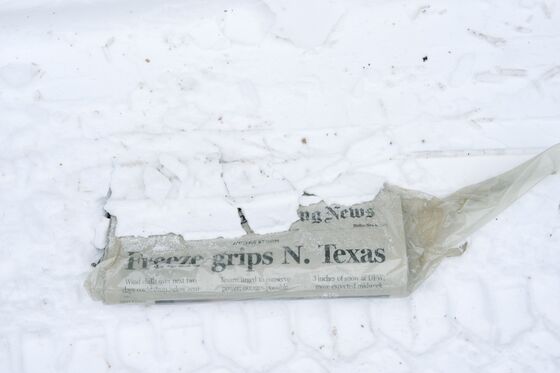
Biden’s Plea to Remake Grid Gets a Boost on Texas Power Crisis
The icy weather that left millions without power in Texas has critics of the Biden administration’s fight against climate change blaming renewable energy, but the failures have more to do with an ill-prepared power grid and shortfalls in traditional electricity sources.
Energy analysts and experts said the blackouts in Texas underscore the U.S. electric system’s need for more of almost everything, from additional power lines criss-crossing the country to large-scale storage systems that can supply electricity when demand spikes or renewable generation declines.
That could give at least a rhetorical boost to President Joe Biden’s plans for a “historic investment” in the nation’s electric grid, including better transmission systems and battery storage that would make the system more resilient amid extreme weather spurred by climate change.
The investments broadly touted by Biden could help satisfy his 2035 goal of an emissions-free power system and help meet increased demand nationwide as more electric vehicles hit the roads and more buildings rely on power instead of natural gas for heat.
The administration is set to unveil a blueprint for infrastructure spending, including investments in the nation’s electrical grid, within weeks.
“There are parts of the country right now that have excess power, that have low prices, that are not struggling, where it’s a normal Tuesday, and yet in Texas, 4 million people are without power,” said Joshua Rhodes, a research associate at the University of Texas at Austin’s Webber Energy Group.
“This should reignite a debate about some kind of connection between our disparate grids where we can move energy to places like Texas that are desperate for it right now.”
The nation’s grid evolved from a patchwork of local power systems that weren’t meant to serve distant customers. “So cities and even some times neighborhoods have their own systems,” Rhodes said. The downside of that approach became became apparent in Texas as temperatures plunged into single digits.
Regional power sources weren’t able to meet the demand as residents cranked up thermostats, straining supplies of electricity in the state known as the energy capital of the U.S. Grid operators were forced to implement rolling blackouts as wind turbines in West Texas froze up and natural gas, coal and nuclear power plants went offline.
“No technologies were spared in this storm of the century,” said Suzanne Bertin, who heads the Texas Advanced Energy Business Alliance.
The solution involves “not putting all of our eggs in one technology basket.”
It’s not the first time the nation’s grid has failed to provide energy where it’s needed. A heat wave across California last August caused a spike in energy demand as residents cranked up air conditioners, forcing rolling blackouts.

And in 2011, after a cold snap forced scores of Texas power plants offline federal regulators recommended installing insulation and heated pipes. Larry Gasteiger, executive director of WIRES, a trade group that advocates for more construction of high-voltage transmission, said the latest crisis in Texas shows the urgent need to build a more resilient grid.
“Climate change is continuing to have a serious impact on the electric system,” Gasteiger said in a phone interview. “We are seeing more and more frequent extreme weather events.”
Cleaner Future
Even without climate-related impacts, grid improvements needed to accommodate a cleaner future with more electric vehicles and electrification could cost as much as $90 billion by 2030 and as much as $600 billion by 2050, according to a study commissioned by WIRES.
Policy makers could encourage greater use of energy storage and more high-voltage power lines to transmit electricity nationwide, said Jeff Dennis, managing director of Advanced Energy Economy, an association of clean energy businesses.
“One of the best things we can do to address a variety of challenges to the grid is build a lot more of that transmission and delivery infrastructure to move resources around from where they’re available to where they are needed,” Dennis said.
Still, on Tuesday, as Texans struggled to stay warm amid 30-plus-hour power outages that caused dangerous dips in even indoor temperatures, supporters of fossil fuels insisted renewables should shoulder much of the blame.
The incident shows the danger in closing coal, natural gas and nuclear power plants that are generally steady suppliers of electricity, said Dan Brouillette, an energy secretary under former President Donald Trump.
“We’ve moved away from that to a more intermittent and frankly sometimes less reliable form of energy in the sense of wind and solar,” Brouillette said on Bloomberg Television.
“We’ve got to address this very squarely and have a very honest conversation about renewable energy in America.”
Subsidy Warnings
Rich Nolan, head of the National Mining Association, bemoaned that “the Texas grid is failing at the exact time the people of Texas need it most.”
The U.S. grid is in transition, Nolan said, but shifts in the nation’s power generation mix need to be thoughtful — “not a rush to embrace market-distorting subsidized renewables.”
But Rhodes, with the University of Texas, said grid managers in Texas generally count on wind energy producers to generate only a fraction of their capacity during winter months.
While many wind turbines did freeze up during the cold snap, other power sources were also bedeviled by the cold. Power plants and wind turbines in Texas typically aren’t “hardened” against cold weather the way they are in the north, making them more susceptible to failure during extreme cold weather.
Frozen instruments triggered shutdowns at gas and coal plants, according to the state’s grid operator. Natural gas flows were pinched as wells froze shut and supplies were diverted to home heating instead of power plants. Icy water even briefly took a nuclear plant in south Texas offline.
Heather Zichal, head of the American Clean Power Association, decried “a politically opportunistic charade” against renewable electricity.














